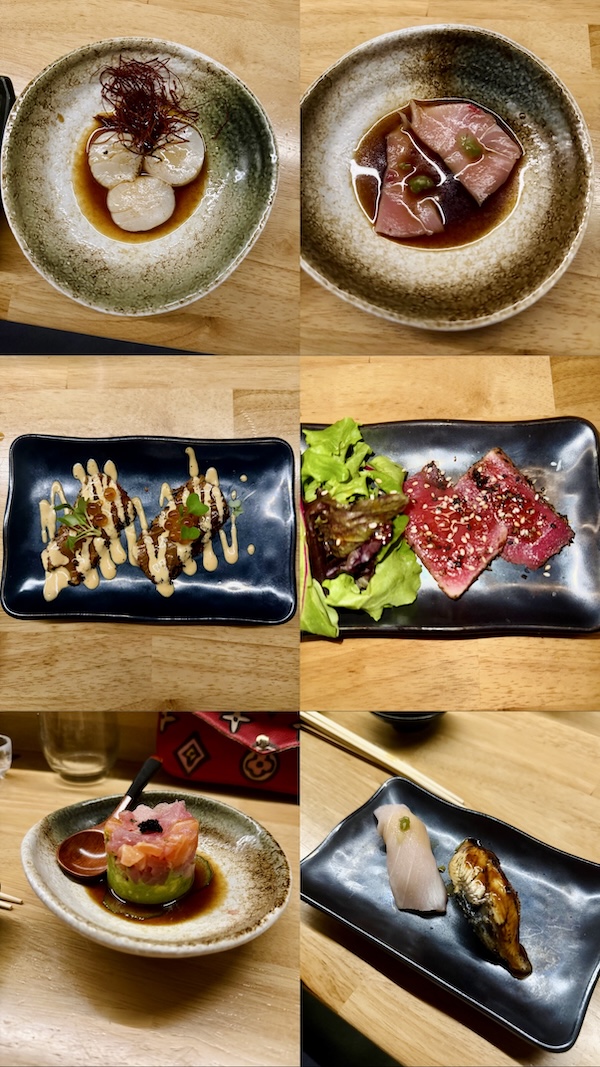The title says it all! An omakase experience, in a speakeasy, at a spot called The Blind Tiger in Aventura. An experience deserving of its 4.8 Google rating.
I was fortunate enough to go during Miami Spice, meaning we were able to try a multi-course tasting menu with the chef’s selection of Japanese delicacies. This experience is always available ont he menu, but Miami Spice allows diners to try a little more for the same price. More bang for your buck sounds good to me!
In this experience, we received a total of 10 dishes!!! Not including dessert. I won’t go through each one individually, but I will guarantee each is equally delicious. High-quality ingredients and simple execution are consistent.
The meal started with Hotate Carpaccio.
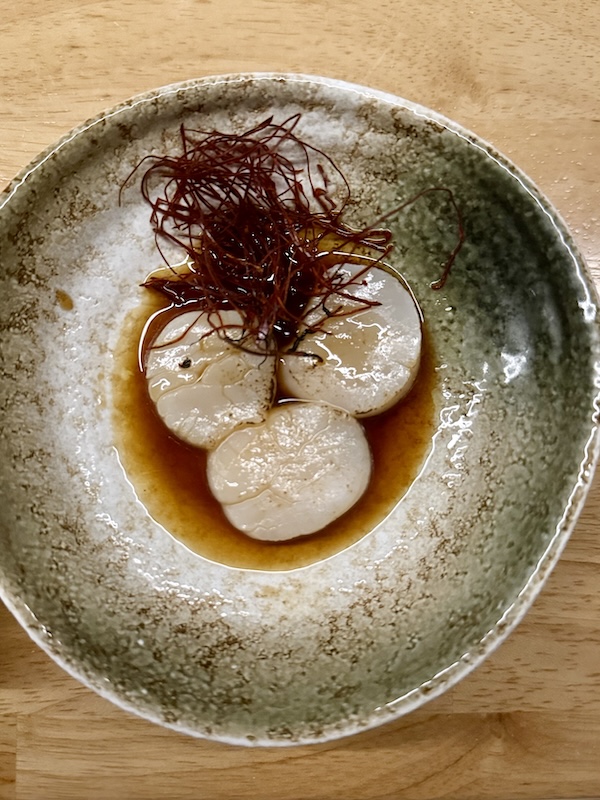
Three coins of hotate sit in a pool of sesame soy. The scallop is cool and satin-soft, with a delicate sweetness. Ginger and garlic show up as a gentle warmth, chives add a clean allium snap, and the chili threads bring just the slightest heat. The balance is spot on: fat from the sesame rounds the salinity, acidity keeps the bite bright, and the finish is long but clean. Overall, delicious and precisely seasoned, it is the kind of opening that makes you giddy for the next dish.
Next to get a shout-out, the Crispy Rice, salmon aburi with ikura:
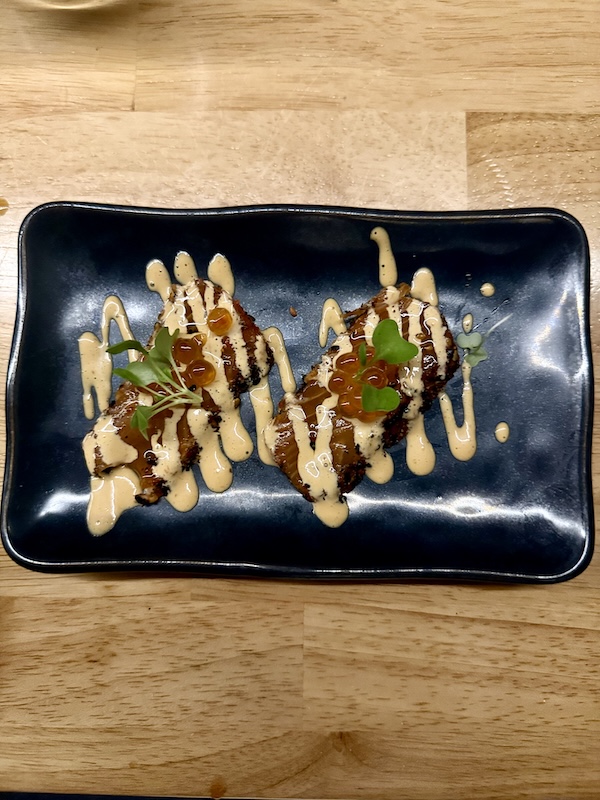
I already love crispy rice. Served after the silky hotate, this texture juxtaposition is just perfect. The rice bar is caramelized on all sides and shatters cleanly. The ikura pops with briny sweetness and keeps the sauces in check. Spicy mayo brings warmth, eel sauce adds a lacquered sweetness, and the microgreens actually make a difference and freshen the finish.
Balance is the win here. Texture moves from crunch to silk, flavor from sweet and smoky to saline and gently spicy. If I nitpick, I’d pull back a touch of mayo to let the aburi flavor speak even louder. Having said that, I wish I could bottle up the spicy mayo and have it available at all times as well. As served, it is crowd-pleasing, rich, and polished. A sip of cold lager or a dry junmai ginjo would be a clean pairing.
I must highlight what was arguably the favorite, the Tuna and Salmon Tartare Tower:
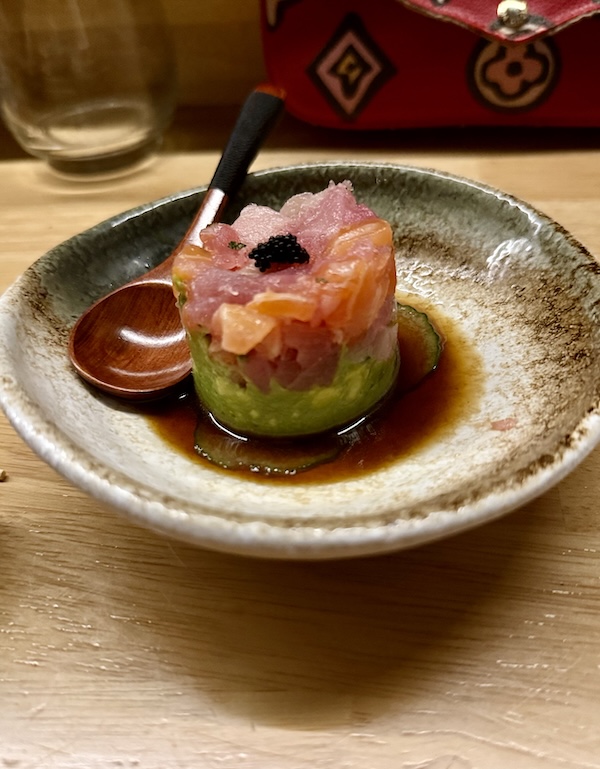
A layered tartare of diced tuna and salmon over avocado, set on thin cucumbers in a ponzu-style soy dressing, finished with a touch of caviar.
The fish is cold and silky, cut clean so it eats plush rather than mushy. Avocado adds creaminess without dulling flavor. The cucumbers keep the base crisp, and the caviar gives a briny pop that lengthens the finish. The ponzu has bright acidity, lifting both fish without overpowering them.
Scoop through all three layers so you get cool fish, buttery avocado, and the cucumber in a single bite. You taste tuna first, then salmon’s richer fat, then a citrus-soy echo that keeps you reaching for the spoon.
Speaking of tuna, I also really loved the Tuna Tataki with Sesame and Greens:

Thin slices of lightly seared tuna glazed with a soy-citrus reduction, sprinkled with sesame, and served alongside a simple green salad. Tuna is the perfect fish for an omakase experience because of the depth of flavor it naturally has. Here, it is beautifully executed.
The tuna is ruby in the center with a clean, even sear at the edge, which gives a gentle warmth and a bit of smoke without cooking past rare. The glaze reads sweet-salty with a bright citrus lift, so you taste the fish first and the sauce second. Toasted sesame adds nutty crunch that plays well against the silky texture of the tuna. The greens do real work here, bringing a fresh, slightly bitter snap that resets the palate between bites.
Tataki is about restraint, and the kitchen nails it. The slices are cut clean, the seasoning is confident but not heavy, and the temperature is spot on. As a mid-omakase course, it bridges richer plates like crispy rice and the heavier hand rolls while keeping the progression light and focused.
And a potential sleeper that is perfectly prepared: the Hamachi Usuzukuri with Yuzu Ponzu and Yuzu Koshō.
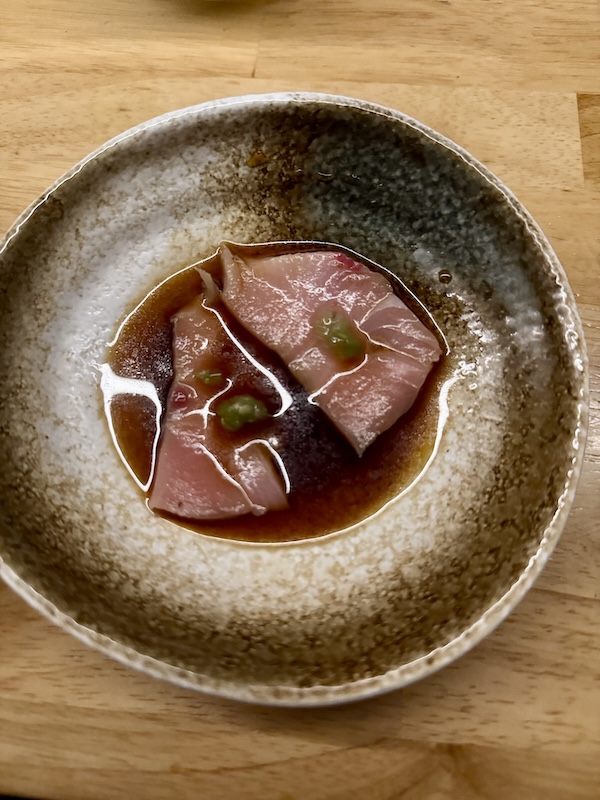
What is it? Thinly sliced hamachi (yellowtail) laid in a shallow bath of yuzu-ponzu, dotted with a pea of yuzu koshō (the citrus-chile paste) on each slice.
The chef trims a center-loin cut, then slices against the grain into nearly translucent petals, usuzukuri style, so the fish eats satin-soft. A quick dip in ponzu lightly “cures” the surface, tightening the flesh just enough to concentrate its natural sweetness. The yuzu koshō lands last, adding perfumed heat and a citrusy bloom that rides the fish rather than burying it.
Buttery, clean, and gently oceanic from the hamachi; bright, savory, and faintly smoky from the ponzu (soy, citrus, a whisper of dashi); then a pinpoint spark of yuzu and green-chile heat that lifts the finish. In each bite you get a cool silk, vivid citrus and return to a long, umami echo.
This is the most clean and pure course in my opinion. The second half of the meal consists of hand rolls and nigiri.
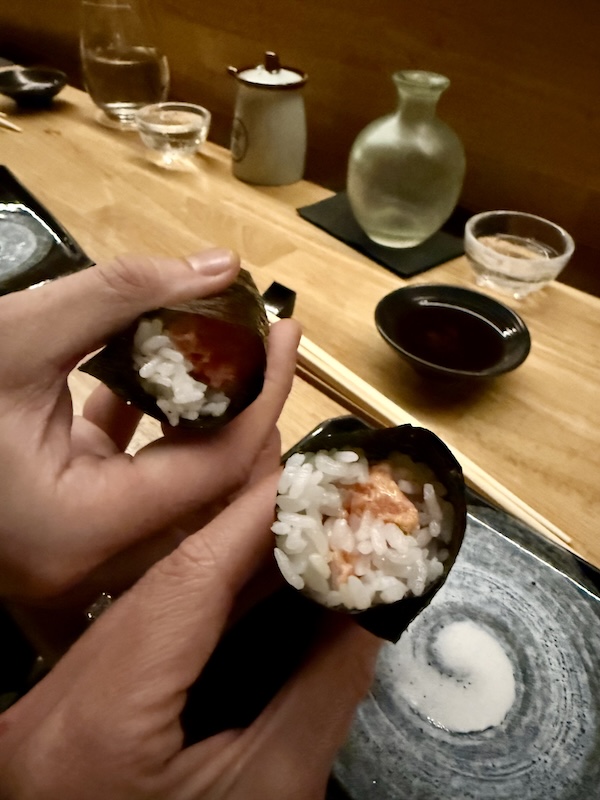
Two hand rolls come with Miami Spice. Here we have the Salmon Temaki (Spicy Salmon Hand Roll). Crisp nori wrapped around warm sushi rice with chopped salmon and a light spicy mayo. Eat immediately so the nori stays crackly. You get a bit of toast from the seaweed, warm-vinegared from the rice, and rich, slightly spicy from the salmon.
The Scallop Temaki (Hotate Hand Roll) was the more subdued of the 2. Nori is filled with warm sushi rice and chopped raw scallop. A minimalist, but still delicious, transition into the nigiri portion of the meal.
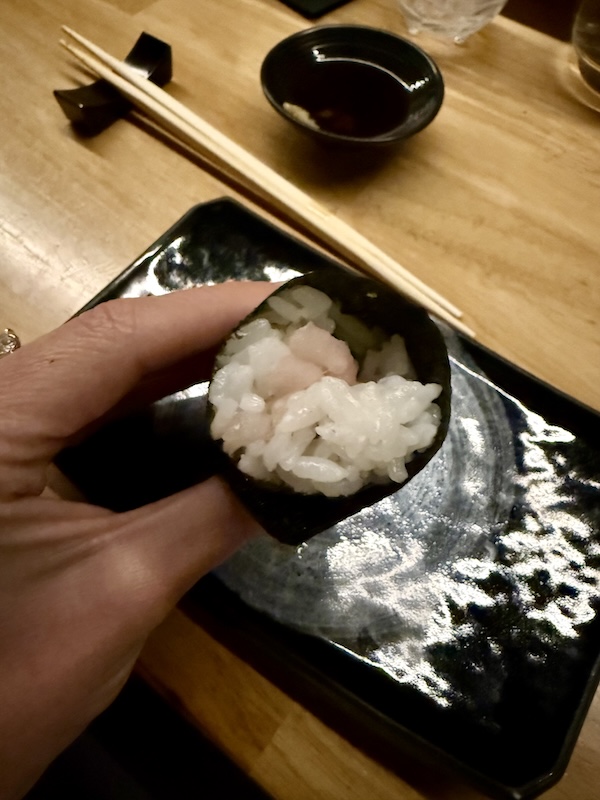
After these delicious rolls, you’re ripe for the nigiri. I cannot stress enough how perfect every bite is. Buttery, flavorful, fresh, and just perfectly topped. If I’ve recounted anything incorrectly, you’ll have to forgive me. Just know that whatever the chef selects, you’re in good hands. Tip: Eat each in one bite, fish-side down, so you catch the toppings and the chef’s nikiri soy first.
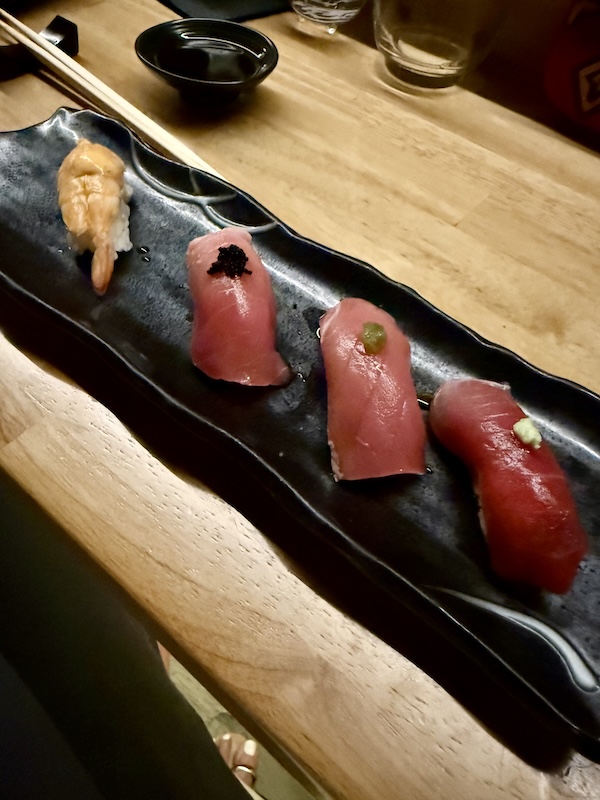
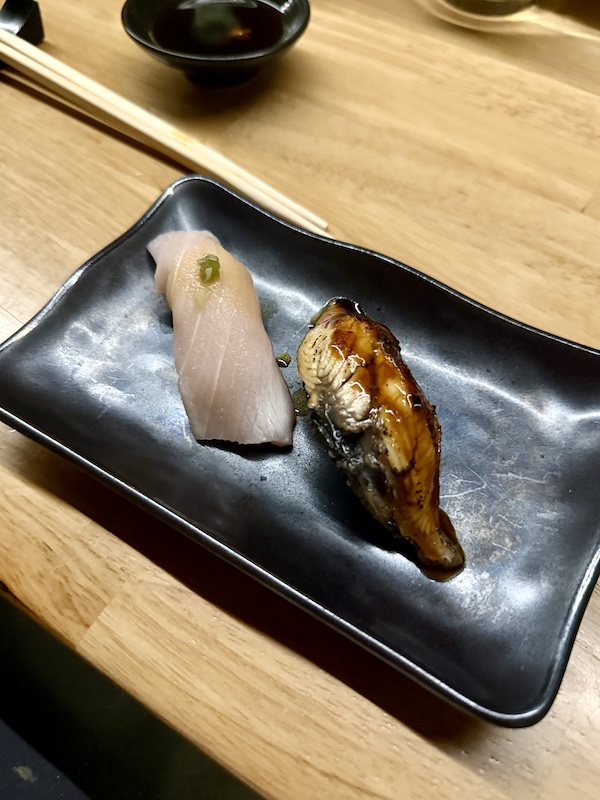
Left to right:
- Ebi nigiri – cooked shrimp over seasoned rice. Sweet, clean, a little snap.
- Maguro (akami) nigiri with caviar – lean tuna topped with a small spoon of caviar for briny pop.
- Maguro (akami) nigiri with yuzu koshō – lean tuna with a citrus-chile paste that adds perfume and gentle heat.
- Maguro (akami) nigiri (light wasabi under the fish) – the pure, unadorned cut.
- Hamachi nigiri (yellowtail) topped with a dab of yuzu koshō.
- Unagi nigiri (freshwater eel) glazed with sweet soy tare (eel sauce), lightly torched.
And that rounds out a 5 star omakase experience.
The food led the night with the kind of calm showmanship you want at sushi: clean knife work and thoughtful pacing. The Miami Spice progression is a smart value that still feels premium, moving from bright, balanced small plates to pristine nigiri and crackly hand rolls without a lull. I would go back outside of Spice month, which is the best compliment a Spice menu can earn.

